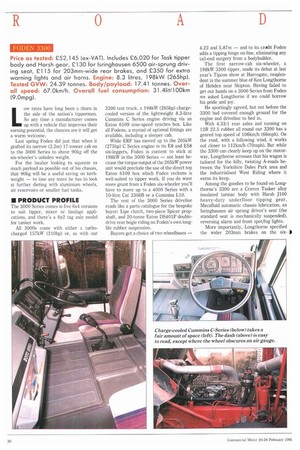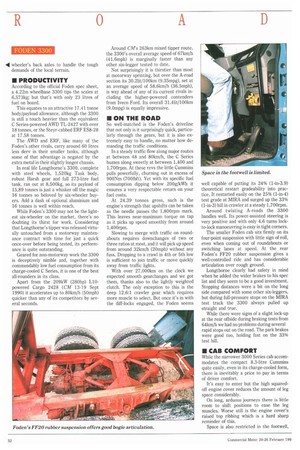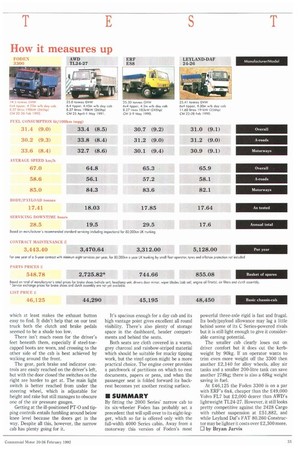FODEN 3300
Page 32

Page 34

Page 35

If you've noticed an error in this article please click here to report it so we can fix it.
Price as tested: £52,145 (ex-VAT). Includes 26,020 for Task tipper body and Harsh gear, £130 for lsringhausen 6500 air-sprung driving seat, £115 for 203mm-wide rear brakes, and 2350 for extra warning lights and air horns. Engine: 8.3 litres, 198kW (265hp). Tested GVW: 24.39 tonnes. Body/payload: 17.41 tonnes. Overall speed: 67.0km/h. Overall fuel consumption: 31.41it/100km (9.0mpg).
Low rates have long been a thorn in the side of the nation's tipperrnen. So any time a manufacturer comes up with a vehicle that improves their earning potential, the chances are it will get a warm welcome.
Last spring Foden did just that when it grafted its narrow (2.2m) 17-tonner cab on to the 3000 Series to shave 90kg off the six-wheeler's unladen weight.
For the haulier looking to squeeze as much payload as possible out of his chassis, that 90kg will be a useful saving on kerbweight — to lose any more he has to look at further dieting with aluminium wheels, air reservoirs or smaller fuel tanks.
• PRODUCT PROFILE
The 3000 Series comes in five 6x4 versions to suit tipper, mixer or haulage applications, and there's a 6x2 tag axle model for tanker work.
All 3000s come with either a turbocharged 157kW (210hp) or, as with our 3300 test truck, a 198kW (265hp) chargecooled version of the lightweight 8.3-litre Cummins C Series engine driving via an Eaton 6109 nine-speed synchro box. Like all Fodens, a myriad of optional fittings are available, including a sleeper cab.
While ERF has moved up to the 205kW (275hp) C Series engine in its E8 and ES8 six-leggers, Foden is content to stick at 198kW in the 3000 Series — not least because the torque output of the 205kW power unit would preclude the use of the direct top Eaton 6109 box which Foden reckons is well-suited to tipper work. If you do want more grunt from a Foden six-wheeler you'll have to move up to a 4000 Series with a 10-litre Cat 3306B or a Cummins Lb.
The rest of the 3000 Series driveline reads like a parts catalogue for the bespoke buyer: Lipe clutch, two-piece Spicer propshaft, and 20-tonne Eaton DS401P doubledrive rear bogie riding on Foden's own longlife rubber suspension.
Buyers get a choice of two wheelbases — 4.22 and 5.87m — and to its credit Foden adds a tipping hinge on-line, eliminating any tail-end surgery from a bodybuilder.
The first narrow-cab six-wheeler, a 198kW 3300 tipper, made its debut at last year's Tipcon show at Harrogate, resplendent in the summer blue of Ken Longthorne of Hebden near Skipton. Having failed to get our hands on a 3000 Series from Foden we asked Longthorne if we could borrow his pride and joy.
He sportingly agreed, but not before the 3300 had covered enough ground for the engine and driveline to bed in.
With 4.33:1 rear axles and running on 12R 22.5 rubber all round our 3300 has a geared top speed of 1061(m/h (66mph). On the road, with a following wind, it works out closer to 112km/h (70mph). But while the 3300 can clearly keep up on the motorway, Longthorne stresses that his wagon is tailored for the hilly, twisting A-roads between the Yorkshire Dales Park area and the industrialised West Riding where it earns its keep.
Among the goodies to be found on Longthome's 3300 are a Craven Tasker alloy insulated tarmac body with Harsh J100 heavy-duty underfloor tipping gear, Mecafluid automatic chassis lubrication, an Isringhausen air sprung driver's seat (the standard seat is mechanically suspended), reversing alarm and front spot/fog lights.
More importantly, Longthorne specified the wider 203mm brakes on the six0 wheeler's back axles to handle the tough demands of the local terrain.
• PRODUCTIVITY
According to the official Foden spec sheet, a 4.22m wheelbase 3300 tips the scales at 6,573kg; but that's with only 23 litres of fuel on board.
This equates to an attractive 17.41 tonne body/payload allowance, although the 3300 is still a touch heavier than the equivalent C Series-powered AWD TL-2427 with over 18 tonnes, or the Steyr-cabbed ERF ES8-28 at 17.58 tonnes.
The AIND and ERF, like many of the Foden's other rivals, carry around 60 litres less dery in their smaller tanks, although some of that advantage is negated by the extra metal in their slightly longer chassis.
In real life Longthorne's 3300, complete with steel wheels, 1,520kg Task body, robust Harsh gear and full 273-litre fuel tank, ran out at 8,500kg, so its payload of 15,89 tonnes is just a whisker off the magic 16 tonnes so beloved by six-wheeler buyers. Add a dash of optional aluminium and 16 tonnes is well within reach.
While Foden's 3300 may not be the lightest six-wheeler on the market, there's no doubting its thirst for work. Considering that Longthorne's tipper was released virtually untouched from a motorway maintenance contract with time for just a quick once-over before being tested, its performance is quite outstanding.
Geared for non-motorway work the 3300 is deceptively nimble and, together with commendably low fuel consumption from its charge-cooled C Series, it is one of the best all-rounders in its class.
Apart from the 209kW (280hp) L10powered Cargo 2428 (CM 13-19 Sept 1990) it accelerates up to 80km/h (50mph) quicker than any of its competitors by several seconds. Around CM's 263km mixed tipper route, the 3300's overall average speed of 67km/h (41.6mph) is marginally faster than any other six-legger tested to date.
Not surprisingly it is thirstier than most at motorway sprinting, but over the A-road section its 30.21it/100km (9.35mpg), set at an average speed of 58.6km/h (36.5mph), is way ahead of any of its current rivals including the higher-powered contenders from Iveco Ford. Its overall 31.41it/100km (9.0mpg) is equally impressive.
• ON THE ROAD So well-matched is the Foden's driveline that not only is it surprisingly quick, particularly through the gears, but it is also extremely easy to handle, no matter how demanding the traffic conditions.
In a steady traffic flow along major routes at between 48 and 80km/h, the C Series buzzes along sweetly at between 1,400 and 1,700rpm. At these revs the little Cummins pulls powerfully, churning out in excess of 900Nm (700Ibft). Yet with its specific fuel consumption dipping below 200g/kWh it ensures a very respectable return on your fuel costs.
At 24.39 tonnes gross, such is the engine's strength that upshifts can be taken as the needle passes the 1,800rpm mark. This leaves near-maximum torque on tap as it picks up speed smoothly from around 1,40Orpm.
Slowing to merge with traffic on roundabouts requires downchanges of two or three ratios at most, and it will pick up speed from around 32km/h (20mph) without any fuss. Dropping to a crawl in 4th or 5th low is sufficient to join traffic or move quickly away from traffic lights.
With over 27,000km on the clock we expected smooth gearchanges and we got them, thanks also to the lightly weighted clutch. The only exception to this is the deep 12.6:1 crawler gear which requires more muscle to select. But once it's in with the diff-locks engaged, the Foden seems well capable of putting its 24% (1-in-3.9) theoretical restart gradeability into practice. It restarted easily on the 25% (1-in-4) test grade at MIRA and surged up the 33% (1-in-3) hill in crawler at a steady 1,700rpm.
Around twisting A-roads the 3300 handles well. Its power-assisted steering is very positive and with only 4.6 turns lockto-lock manoeuvring is easy in tight corners.
The smaller Foden cab sits firmly on its four-point suspension with little sign of roll, even when coming out of roundabouts or switching lanes at speed. At the rear Foden's FF20 rubber suspension gives a well-controlled ride and has considerable articulation over rough ground.
Longthorrie clearly had safety in mind when he added the wider brakes to his spec list and they seem to be a good investment. Stopping distances were a bit on the long side compared with some other six-leggers, but during full-pressure stops on the MIRA test track the 3300 always pulled up straight and true.
While there were signs of a slight lock-up at the rear offside during braking tests from 64km/h we had no problems during several rapid stops out on the road. The park brakes were good too, holding fast on the 33% test hill.
• CAB COMFORT
While the narrower 3000 Series cab accommodates the compact 8.3-litre Cummins quite easily, even in its charge-cooled form, there is inevitably a price to pay in terms of driver comfort.
It's easy to enter but the high squaredoff engine cover reduces the amount of leg space considerably.
On long, arduous journeys there is little room to shift positions to ease the leg muscles. Worse still is the engine cover's raised top ribbing which is a hard sharp reminder of this.
Space is also restricted in the footwell, which at least makes the exhaust button easy to find. It didn't help that on our test truck both the clutch and brake pedals seemed to be a shade too low.
There isn't much room for the driver's feet beneath them, especially if steel-toecapped boots are worn, and crossing to the other side of the cab is best achieved by walking around the front.
The gear, park brake and indicator controls are easily reached on the driver's left, but with the door closed the switches on the right are harder to get at. The main light switch is better reached from under the steering wheel, which is adjustable for height and rake but still manages to obscure one of the air pressure gauges.
Getting at the ill-positioned PT-0 and tipping controls entails fumbling around below knee level because the doors get in the way. Despite all this, however, the narrow cab has plenty going for it. It's spacious enough for a day cab and its high vantage point gives excellent all round visibility. There's also plenty of storage space in the dashboard, header compartments and behind the seats.
Both seats are cloth covered in a warm, grey charcoal and rainbow-striped material which should be suitable for mucky tipping work, but the vinyl option might be a more practical choice. The engine cover provides a patchwork of partitions on which to rest documents, papers or pens, and when the passenger seat is folded forward its backrest becomes yet another resting surface.
• SUMMARY
By fitting the 2000 Series' narrow cab to its six-wheeler Foden has probably set a precedent that will spill over to its eight-legger, which so far is offered only with the full-width 4000 Series cabin. Away from a motorway this version of Foden's most
powerful three-axle rigid is fast and frugal. Its body/payload allowance may lag a little behind some of its C Series-powered rivals but it is still light enough to give it considerable earning potential.
The smaller cab clearly loses out on driver comfort but it does cut the kerbweight by 90kg. If an operator wants to trim even more weight off the 3300 then another £2,140 for alloy wheels, alloy air tanks and a smaller 200-litre tank can save another 278kg; there is also a 68kg weight saving in fuel.
At £46,125 the Foden 3300 is on a par with ERF's 6x4, cheaper than the £49,000 Volvo FL7 but £2,000 dearer than AWD's lightweight TL24-27. However, it stilllooks pretty competitive against the 2428 Cargo with rubber suspension at £51,882, and while Leyland Daf's FAT 80.260 Constructor may be lighter it costs over £2,300 more. LI by Bryan Jarvis




















































































